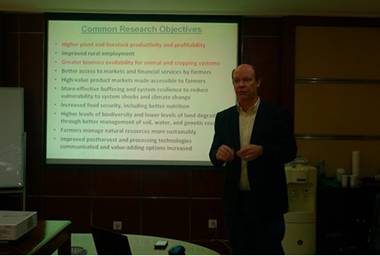Professor William Payne from Consultative Group on International Agricultural Research Visits XIEG
2013-03-26
On March 15, 2013, Dr. William Payne, director of Consultative Group on International Agricultural Research (CGIAR) Program on Dryland Systems and the professor from Texas A&M University, visited Xinjiang Institute of Ecology and Geography, Chinese Academy of Sciences (XIEG) and conducted academic exchange with researchers from XIEG.
CHEN Xi, director of XIEG, introduced the research fields in XIEG firstly. Then, Prof. Payne presented the scopes, study area and objectives of the CGIAR Research Program on Dryland Systems. He also introduced his own research work on increasing the transpiration efficiency in grain sorghum in Texas A&M University.
At the symposium, Dr. QIAO Jianfang introduced the general survey of XIEG and the research progress obtained in international cooperation. Based on the topic of “Biodiversity and Its Protection in Central Asia”, Prof GUAN Kaiyun from XIEG presented the basic situation of the biodiversity in Central Asia. Lastly, Dr. WANG Yongdong and LI Chaofan presented the research progress obtained by XIEG in cooperation with Africa and Central Asia, respectively.
After the symposium, Prof. Payne visited the specimen museum and laboratory of XIEG, Fukang National Field Scientific Observation and Research Station for Desert Ecosystems, and Turpan Eremophytes Botanical Garden, CAS. He gave a high praise on the achievements of XIEG in the fields of eco-environment and biodiversity conservation in arid land. The both sides will gradually conduct multi-level cooperation on the agricultural and biodiversity conservation in arid land and obtain substantial cooperation results.
Dryland Systems is the first-ever global-scale research program to use an innovative, integrated agro-ecosystem approach involving multi-stakeholders to improve agricultural productivity, protect the planet, and alleviate poverty and hunger in dry areas. It aims to provide the poorest and most vulnerable with the means and capabilities to contribute to innovation, benefit from those innovations and enhance their own livelihoods.
The Dryland Systems program works together with an array of public and private partners in five targeted regions, including 1) West Africa and the Dry Savannas, 2) Eastern and Southern Africa, 3) North Africa and West Asia, 4) South Asia, and 5) Central Asia.

Prof. William Payne



